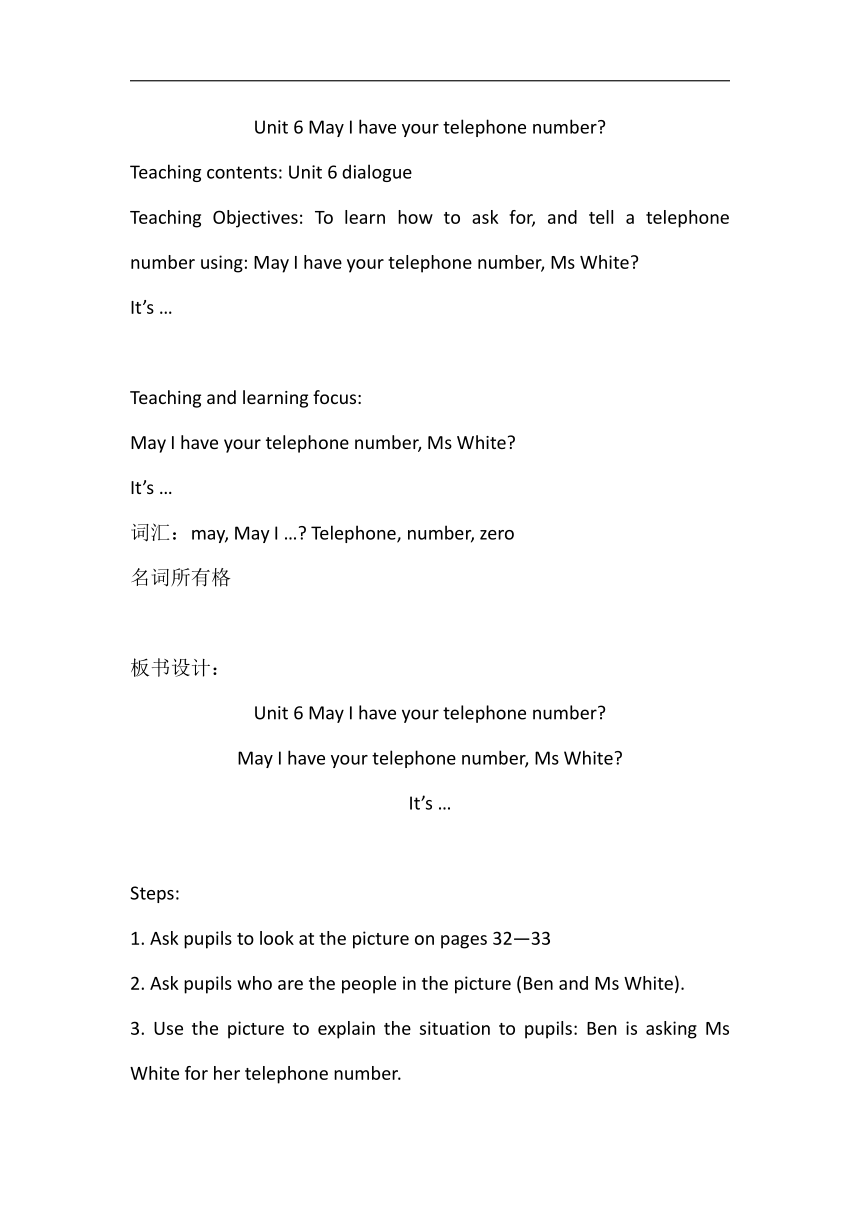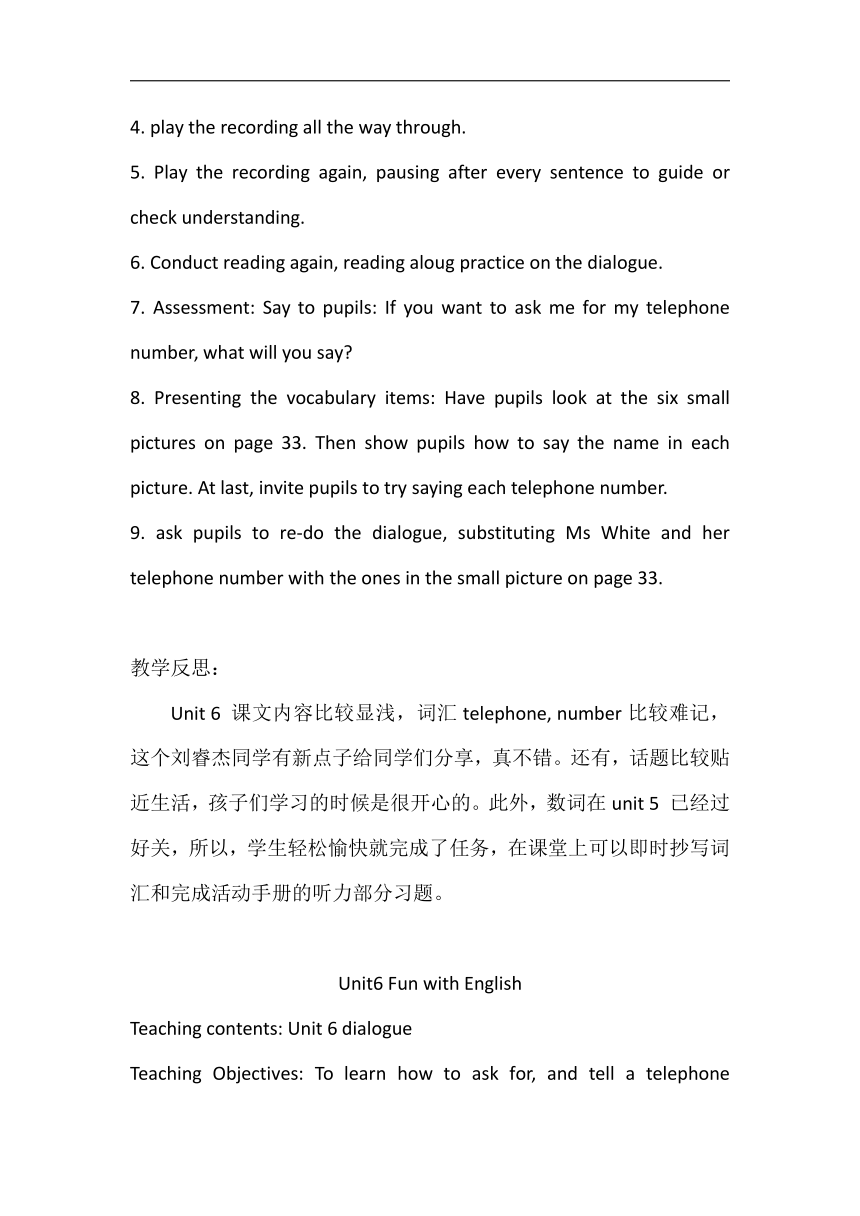Module 3 Personal information Unit6 May I have your telephone number 教案
文档属性
| 名称 | Module 3 Personal information Unit6 May I have your telephone number 教案 |

|
|
| 格式 | docx | ||
| 文件大小 | 15.5KB | ||
| 资源类型 | 教案 | ||
| 版本资源 | 教科版(广州) | ||
| 科目 | 英语 | ||
| 更新时间 | 2022-05-11 18:05:52 | ||
图片预览


文档简介
Unit 6 May I have your telephone number
Teaching contents: Unit 6 dialogue
Teaching Objectives: To learn how to ask for, and tell a telephone number using: May I have your telephone number, Ms White
It’s …
Teaching and learning focus:
May I have your telephone number, Ms White
It’s …
词汇:may, May I … Telephone, number, zero
名词所有格
板书设计:
Unit 6 May I have your telephone number
May I have your telephone number, Ms White
It’s …
Steps:
1. Ask pupils to look at the picture on pages 32—33
2. Ask pupils who are the people in the picture (Ben and Ms White).
3. Use the picture to explain the situation to pupils: Ben is asking Ms White for her telephone number.
4. play the recording all the way through.
5. Play the recording again, pausing after every sentence to guide or check understanding.
6. Conduct reading again, reading aloug practice on the dialogue.
7. Assessment: Say to pupils: If you want to ask me for my telephone number, what will you say
8. Presenting the vocabulary items: Have pupils look at the six small pictures on page 33. Then show pupils how to say the name in each picture. At last, invite pupils to try saying each telephone number.
9. ask pupils to re-do the dialogue, substituting Ms White and her telephone number with the ones in the small picture on page 33.
教学反思:
Unit 6 课文内容比较显浅,词汇telephone, number比较难记,这个刘睿杰同学有新点子给同学们分享,真不错。还有,话题比较贴近生活,孩子们学习的时候是很开心的。此外,数词在unit 5 已经过好关,所以,学生轻松愉快就完成了任务,在课堂上可以即时抄写词汇和完成活动手册的听力部分习题。
Unit6 Fun with English
Teaching contents: Unit 6 dialogue
Teaching Objectives: To learn how to ask for, and tell a telephone number using: May I have your telephone number, Ms White
It’s …
Teaching and learning focus:
May I have your telephone number, Ms White
It’s …
词汇:may, May I … Telephone, number, zero
名词所有格
板书设计:
Unit 6 May I have your telephone number
May I have your telephone number, Ms White
It’s …
Steps:
1. In this task, for each question, two possible answers which differ only slightly are given. Pupils have to listen carefully for the correct one.
2. Write the first set of telephone numbers on the blackboard: 3568901 and 3567901.
3. Invite pupils to read aloud each telephone number.
4. Draw pupils’ attention to the slight difference between the two numbers. You may choose and say one of the numbers and ask pupils which one you said.
5. Explain the listening task.
6. Play the recording, pausing after each question for pupils to tick the correct answer.
7. Assessment: When pupils have finished the listening task and you have checked the answers with them, you may ask: What’s Ben’s telephone number Pupils say the telephone number according to the right answer.
8. As above, but pupils will work in pairs. P1 choose the name of a child and asks P2 the child’s telephone number.
9. Finish 1. Listen and tick
In this activity, pupils are given 3 jumbled paragraphs and pictures. They have to read the 3 segments carefully and put them in the correct order.
Talk generally about each picture with the pupils.
Explain to pupils that Ben is asking Janet about something. The 3 parts make up their conversation. They are asked to read the 3 parts carefully and put them in the correct order.
Give pupils time to do the reading and ordering.
When pupils have finished, poll the class on the sequence of the pictures that they have come up with.
Tell pupils the correct order, and ask them to read the dialogue again.
Conduct some activities for the students to read the dialogue aloud.
Act out the correct dialogue.
10. Finish 2. Read and order. Finish 3 Write and say
Ask pupils write down their names, their phone numbers, and their QQ numbers, then tell others the information orally.
Have pupils look at the form in the book. Alternatively, bring a form to the lesson.
Explain the task. Give pupils time to write down their information in the form.
In groups, pupils take turns to tell their personal information to each other.
11. End the lesson and homework assignment.
教学反思:
讲练结合符合孩子的学习能力,数字学习还是轻松,用各种形式的跨学科运用的综合题目,学生在课堂中发展多元智能,符合新课程标准的要求。课文的替换练习,在学生的表演中显得特别有趣,他们对于这个读错号码的小细节觉得很有趣,学生的注意力一下子就被抓住了。
Teaching contents: Unit 6 dialogue
Teaching Objectives: To learn how to ask for, and tell a telephone number using: May I have your telephone number, Ms White
It’s …
Teaching and learning focus:
May I have your telephone number, Ms White
It’s …
词汇:may, May I … Telephone, number, zero
名词所有格
板书设计:
Unit 6 May I have your telephone number
May I have your telephone number, Ms White
It’s …
Steps:
1. Ask pupils to look at the picture on pages 32—33
2. Ask pupils who are the people in the picture (Ben and Ms White).
3. Use the picture to explain the situation to pupils: Ben is asking Ms White for her telephone number.
4. play the recording all the way through.
5. Play the recording again, pausing after every sentence to guide or check understanding.
6. Conduct reading again, reading aloug practice on the dialogue.
7. Assessment: Say to pupils: If you want to ask me for my telephone number, what will you say
8. Presenting the vocabulary items: Have pupils look at the six small pictures on page 33. Then show pupils how to say the name in each picture. At last, invite pupils to try saying each telephone number.
9. ask pupils to re-do the dialogue, substituting Ms White and her telephone number with the ones in the small picture on page 33.
教学反思:
Unit 6 课文内容比较显浅,词汇telephone, number比较难记,这个刘睿杰同学有新点子给同学们分享,真不错。还有,话题比较贴近生活,孩子们学习的时候是很开心的。此外,数词在unit 5 已经过好关,所以,学生轻松愉快就完成了任务,在课堂上可以即时抄写词汇和完成活动手册的听力部分习题。
Unit6 Fun with English
Teaching contents: Unit 6 dialogue
Teaching Objectives: To learn how to ask for, and tell a telephone number using: May I have your telephone number, Ms White
It’s …
Teaching and learning focus:
May I have your telephone number, Ms White
It’s …
词汇:may, May I … Telephone, number, zero
名词所有格
板书设计:
Unit 6 May I have your telephone number
May I have your telephone number, Ms White
It’s …
Steps:
1. In this task, for each question, two possible answers which differ only slightly are given. Pupils have to listen carefully for the correct one.
2. Write the first set of telephone numbers on the blackboard: 3568901 and 3567901.
3. Invite pupils to read aloud each telephone number.
4. Draw pupils’ attention to the slight difference between the two numbers. You may choose and say one of the numbers and ask pupils which one you said.
5. Explain the listening task.
6. Play the recording, pausing after each question for pupils to tick the correct answer.
7. Assessment: When pupils have finished the listening task and you have checked the answers with them, you may ask: What’s Ben’s telephone number Pupils say the telephone number according to the right answer.
8. As above, but pupils will work in pairs. P1 choose the name of a child and asks P2 the child’s telephone number.
9. Finish 1. Listen and tick
In this activity, pupils are given 3 jumbled paragraphs and pictures. They have to read the 3 segments carefully and put them in the correct order.
Talk generally about each picture with the pupils.
Explain to pupils that Ben is asking Janet about something. The 3 parts make up their conversation. They are asked to read the 3 parts carefully and put them in the correct order.
Give pupils time to do the reading and ordering.
When pupils have finished, poll the class on the sequence of the pictures that they have come up with.
Tell pupils the correct order, and ask them to read the dialogue again.
Conduct some activities for the students to read the dialogue aloud.
Act out the correct dialogue.
10. Finish 2. Read and order. Finish 3 Write and say
Ask pupils write down their names, their phone numbers, and their QQ numbers, then tell others the information orally.
Have pupils look at the form in the book. Alternatively, bring a form to the lesson.
Explain the task. Give pupils time to write down their information in the form.
In groups, pupils take turns to tell their personal information to each other.
11. End the lesson and homework assignment.
教学反思:
讲练结合符合孩子的学习能力,数字学习还是轻松,用各种形式的跨学科运用的综合题目,学生在课堂中发展多元智能,符合新课程标准的要求。课文的替换练习,在学生的表演中显得特别有趣,他们对于这个读错号码的小细节觉得很有趣,学生的注意力一下子就被抓住了。
同课章节目录
- Module 1 Colours
- Unit 1 I like red
- Unit 2 Let's colour it
- Module 2 Positions
- Unit 3 Where's my car?
- Unit 4 Is it in your bag?
- Module 3 Personal information
- Unit 5 Happy birthday!
- Unit 6 May I have your telephone number?
- Module 4 Fruits
- Unit 7 May I have some grapes?
- Unit 8 Apple are good for us
- Module 5 Relatives
- Unit 9 Who is this cute baby?
- Unit 10 How many people are there in your family?
- Module 6 Pets
- Unit 11 They're lovely
- Unit 12 Whose rabbits are these?
- Module 7 Let's look back
